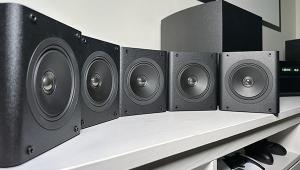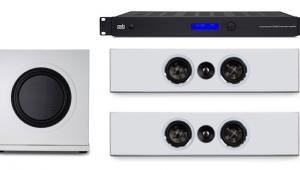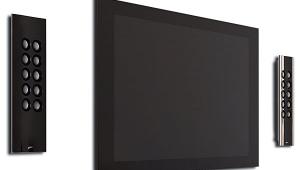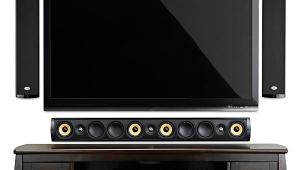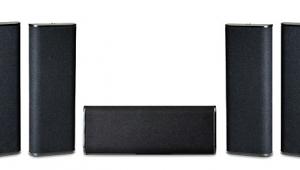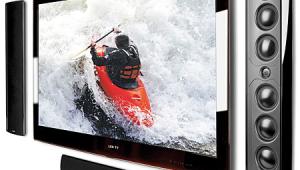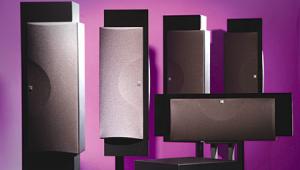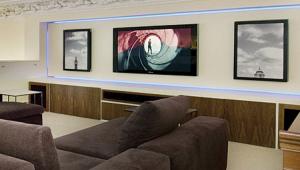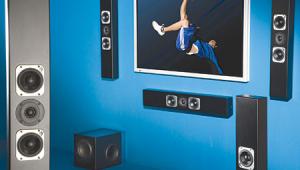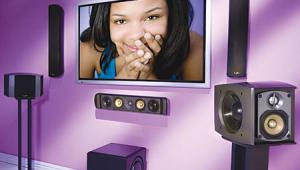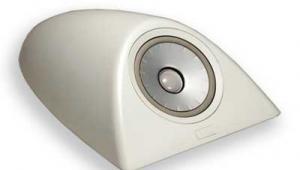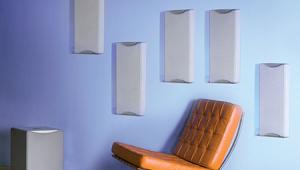Wall Speaks

| The Short Form |
| $3,264 (as tested) / RUSSOUND.COM / 866-222-6997 |
| Snapshot |
| A handsome on-wall speaker system that brings a new tech twist to the category |
| Plus |
| •Unusually wide center-speaker horizontal spread •Excellent tonal match across all front channels •Good subwoofer value •Handsome, simple styling |
| Minus |
| •Some slight low-midrange tonality shifts •Low sensitivity requires lots of amp power |
| Key Features |
| LCR7 ($625 each) •(6) 3½-in cone midrange/woofers •1-in silk dome tweeter; 25¼ x 4½ x 4? in; 17½ lb SUB105 ($499) •10-inch cone woofer; 125-watt amplifier; 18¾ x 12 x 17½ in; 33½ lb |
| Test Bench |
| When positioned vertically as a left/right main or surround speaker, the LCR7 displays reasonably moderate irregularities above 800 Hz, with a 2 dB elevation between 800 Hz and 1.5 kHz and stronger peaks at 3.5 kHz and 12 kHz. It retains the same basic character when used horizontally, but off-axis lobing causes a 4 dB depression at 8 kHz. The SUB105's useful operating range extends up to 250 Hz (-6 dB), and it demonstrates good low-end reach and reasonably strong dynamic capability, delivering 104 dB SPL at 2 meters at 32 Hz and above. - Tom Nousaine |
To the best of my knowledge, Russound is the only substantial consumer-electronics manufacturer in the great north woods of New Hampshire (my home state). In 40-odd years, the Newmarket company has parlayed what began with a simple slide-switch speaker-selector into a veritable empire of multiroom and whole-house gear that includes A/V distribution systems, wall-panel and touchscreen controllers, music/video servers, in-wall speakers - and, yes, speaker selectors.
Until now, Russound has pretty much eschewed the rough-and-tumble world of freestanding and on-wall speakers. But that situation has changed with the release of the Complement LCR7, a slim, all-channels design meant for on-wall mounting to complement (get it?) plasma or LCD flatties.
The LCR7 looks like a lot of other slim speakers, but it's not. Behind the discreetly tailored grille and aluminum cabinet lie not one or two woofers, but six identical 3½-inch midrange/bass drivers, plus a 1-inch soft-dome tweeter. Ordinarily, an array like this is a perfect prescription for wildly uneven off-axis response (and thus lumpy real-world tonal balance), as the multiple drivers "lobe" in complex ways - that is, alternately cancel and reinforce each other at various angles. But the LCR7 isn't ordinary. It's an unusual design known as a Bessel array - or, more exactly, a patent-pending something Russound calls a "Super Bessel Array." This configuration tricks the multiple drivers into behaving more like a single, much larger source.
Technically, a Bessel array is a mathematical construct that apparently can be applied to sound, light, radio, or pretty much any other radiating source. (I say "apparently" because the math is, uh, just a touch over my head - like pretty much everything beyond the quadratic equations I dimly remember from high school.) The payoff, Russound claims, is a speaker with similar axial response for vertical or horizontal placement. As such, it promises effectively identical sound across the front three channels, despite their very dissimilar orientation.
SETUP
That's the theory, anyway. Russound sent me a quintet of black LCR7s ($625 each), with elegantly made extruded-aluminum cabinets and perforated-aluminum grilles. Riding shotgun was Russound's Complement SUB105 ($499), a medium-size 10-inch subwoofer of conventional wood-box construction.
The LCR7 includes a full-length mounting bracket. Affixed to a wall, this yields just under 5 inches total mounting depth, which would match up about right with most current LCD or plasma sets. Not wanting any more holes in my walls, I clamped the left/right Russounds securely vertical on low stands placed hard against the wall and flanking my 52-inch Samsung LCD TV. The center speaker rested horizontally just below the set's bottom edge, and the surrounds went on high shelves to either side of the listening area, horizontally arrayed and toed in a bit toward the rear wall. The SUB105 ended up in my normal sub location, to the left of the left front speaker.
MOVIE PERFORMANCE
After several days' break-in using background music and TV news on all-channels stereo, I just had to begin by comparing the horizontal LCR7 center speaker to the flanking left/right front pair. I was listening for off-axis evenness and overall tonal naturalness, particularly on male announcers - of course, I was auditioning the key feature of the Super Bessel Array design. It works! On direct comparisons using mono material, the center Russound was closer in midbass-to-midrange tonal color to its lateral mates than most woofer/tweeter/woofer speakers I've tested. And it appeared to deliver a broader spread, with fewer "lumps" (obvious tonal changes on male voices) across a wide listening arc - say, 90° from dead-center - as compared to many other center speakers.
But I didn't hear perfect evenness from the LCR7 when used horizontally. There appeared to be two modest principal lobes to either side, at about 35° and 70° off-axis (and not perfectly symmetrical, either) - although these were audibly less severe than the vocal suckouts I've heard from the worst offenders among conventional designs. Listened to straight on, the treble spread was fairly focused with somewhat restricted vertical or horizontal dispersion (depending on the orientation of the speaker). Super Bessel Array does indeed appear to substantially even out midrange spread, but higher frequencies emanating mostly from the LCR7's upper trio of midwoofers still "beamed" a good bit.
Next, I cued up Live Free or Die Hard (a.k.a. The Bruce Willis Retirement Plan) on Blu-ray Disc - a perfect workout for New Hampshire-made speakers. (Delete "Hard" and you have our state motto.) Live Free begins with a bang, and pretty much stays there, with nonstop drama that spans the emotional range all the way from havoc to mayhem. But the soundtrack is reference-grade stuff.
And you know what? The slim Russounds simply got out of the way and presented the movie. Even at near-reference levels - which on the Willis Plan meant regular excursions north of 95 dB SPL in my room - the LCR7 suite remained clean, punchy, and unstressed, with enough headroom in reserve for exclamation points like the rolling-car near-miss in Chapter 15 to make even this jaded old hand jump a little.
The SUB105 proved more capable than I'd expected, given its unprepossessing, fairly generic appearance. But despite its lack of bottom-octave grunt, the sub offered plenty of output down to something below 40 Hz, as well as valuable freedom from the overtly grumbling or thuddy bass of which lower-cost 10-inchers are often guilty. Out back, the LCR7s worked impressively in the surround positions, producing substantial, well-spread, and hard-to-localize surround effects.
MUSIC PERFORMANCE
On stereo music, the LCR7s minus the subwoofer delivered just enough midbass to make for satisfactory casual music listening or everyday (bedroom and kitchen) TV sound. But for home theater or serious music listening, a sub is definitely required. The best crossover setting for the LCR7/SUB 105 combo in my room proved to be 120 Hz, which created a satisfyingly seamless transition from sub to sats.
Listened to alone, the LCR7s revealed a tonal balance that though a tad heavy through the lower-mids, exhibiting a slight loss of detail or naturalness on some male-vocal tones, was appealingly warm and well defined. Highs were smooth, though showing only a modest amount of forwardness or air. But they were extended and refined, and midrange sounds like massed strings were also presented with rich, realistic timbres.
Surround music such as James Taylor's October Road multichannel SACD sounded outstanding, and the Russound system proved capable of surprisingly clean high-volume levels - if given enough power. Which highlights the LCR7's rather modest sensitivity: the Russounds yield about 3 dB less loudness at a given power input than a "typical" two-way bookshelf, so plan accordingly. If a fully cinematic sonic experience is what you're after, an amplifier or receiver that offers 100 watts per channel would by no means be excessive.
BOTTOM LINE
For obvious reasons, on-wall speakers are the hot ticket these days. Russound's solution adds a new-tech wrinkle to the mix, one with a very real, audible benefit. For installations where wall-mounted speakers are the plan, its blend of solid sound, excellent coverage, and simple good looks deserves your attention.
- Log in or register to post comments
